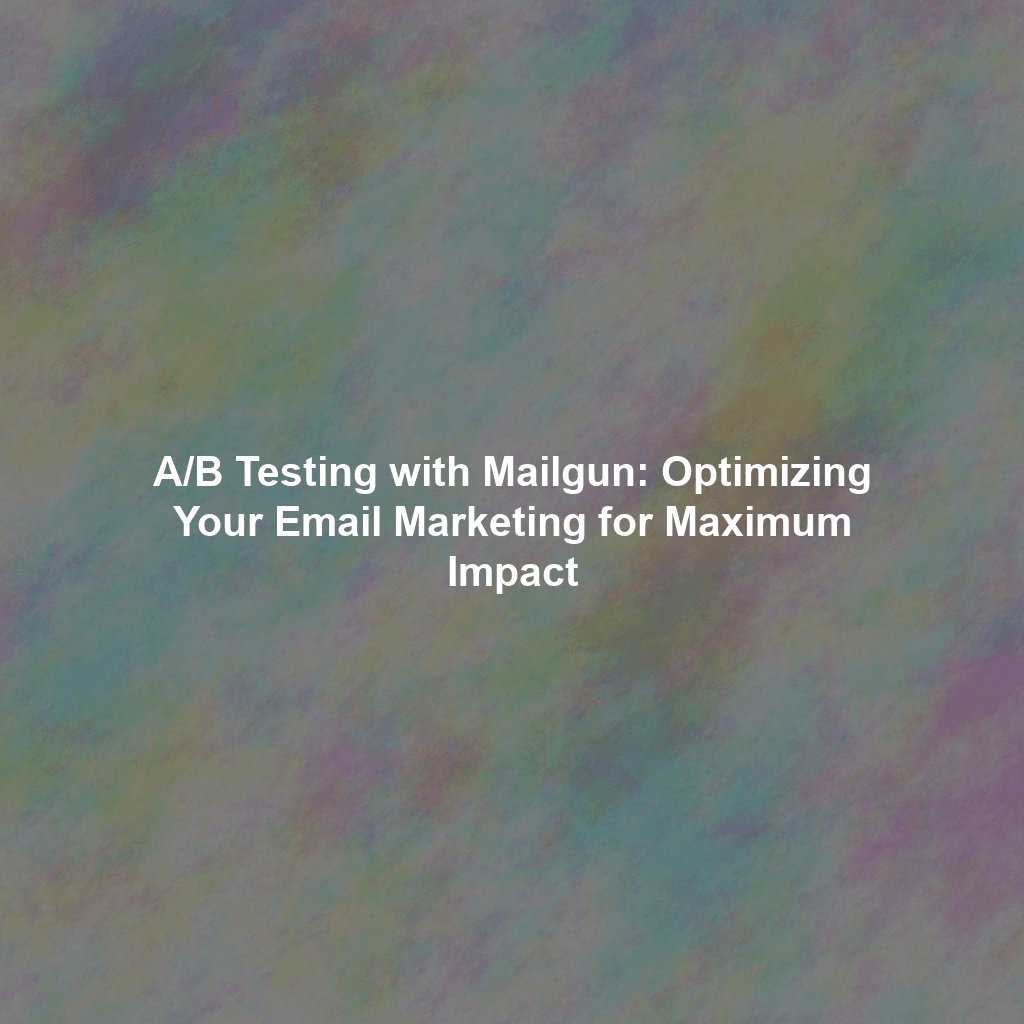Why A/B Testing Matters for Your Email Marketing
A/B testing, also known as split testing, is the process of comparing two versions of an email (A and B) to see which performs better. By systematically testing different elements, you can gain valuable insights into your audience’s preferences and optimize your campaigns for improved results. This translates into:
- Higher Open Rates: Testing different subject lines can dramatically impact whether recipients even open your email.
- Increased Click-Through Rates: Optimized content, calls-to-action, and design can encourage more clicks.
- Improved Conversion Rates: Ultimately, A/B testing helps you drive more sales, sign-ups, or whatever your campaign’s goal may be.
- Reduced Bounce Rates: Understanding what content your audience finds valuable reduces the likelihood of them marking your emails as spam.
- Better ROI: By optimizing each email, you’re making the most of your marketing budget and maximizing your return on investment.
Leveraging Mailgun for A/B Testing
While Mailgun doesn’t have a built-in A/B testing feature *directly* within its dashboard, it provides the necessary infrastructure and flexibility to integrate with various A/B testing tools or implement your own custom solutions. Here’s how you can use Mailgun to facilitate your A/B testing efforts:
Segmentation and List Management
Mailgun’s robust list management features are crucial for A/B testing. You can segment your audience based on demographics, behavior, purchase history, or any other relevant criteria. This allows you to run tests on specific groups, ensuring the results are more relevant and actionable. For example, you might test different offers to customers who have previously purchased specific products.
Integrating with A/B Testing Platforms
Many third-party A/B testing platforms can seamlessly integrate with Mailgun. These platforms provide a user-friendly interface for creating variations, managing tests, and analyzing results. Some popular options include:
- Optimizely: A comprehensive platform offering A/B testing and personalization features.
- VWO (Visual Website Optimizer): Another powerful platform known for its visual editor and advanced targeting capabilities.
- Convertize: A platform focusing on psychological persuasion techniques for optimization.
These platforms typically work by allowing you to design your email variations within their interface. They then use Mailgun’s API to send out the different versions to your segmented lists and track the results. You’ll need to configure the platform to use your Mailgun API key and domain.
Custom A/B Testing Implementation
For more advanced users or those with specific requirements, you can implement your own A/B testing solution using Mailgun’s API. This involves writing code to randomly assign recipients to different versions of your email and track their responses (opens, clicks, etc.). You can then use your own analytics tools to analyze the data and determine the winning variation.
Here’s a simplified example of how you might approach this in Python:
import requests
import random
def send_email(recipient, subject, html):
# Replace with your Mailgun API key and domain
api_key = "YOUR_MAILGUN_API_KEY"
domain = "YOUR_MAILGUN_DOMAIN"
url = f"https://api.mailgun.net/v3/{domain}/messages"
data = {
"from": "Your Name <[email protected]>",
"to": recipient,
"subject": subject,
"html": html
}
response = requests.post(url, auth=("api", api_key), data=data)
return response
def choose_variation(email):
# Simple example: randomly assign to A or B
if random.random() < 0.5:
return "A"
else:
return "B"
# Example usage
recipient_email = "[email protected]"
variation = choose_variation(recipient_email)
if variation == "A":
subject = "Exclusive Offer Inside!"
html = "<p>Version A Content</p>"
else:
subject = "Don't Miss Out on This!"
html = "<p>Version B Content</p>"
response = send_email(recipient_email, subject, html)
print(f"Email sent to {recipient_email} (Variation: {variation}). Response: {response.status_code}")
Important: This is a very basic example. A real-world implementation would involve more robust error handling, tracking mechanisms (e.g., adding unique tracking parameters to links), and data analysis.
What to Test: Key Email Elements for Optimization
The possibilities for A/B testing are endless, but here are some key elements to consider:
Subject Lines
This is often the first (and sometimes only) thing recipients see. Test different approaches like:
- Urgency: “Limited Time Offer!” vs. “Exclusive Discount”
- Personalization: “[Name], Check Out This Deal” vs. “New Arrivals Just For You”
- Emojis: Using emojis can sometimes increase open rates, but test their effectiveness with your audience.
Email Content
The body of your email is where you can really influence click-throughs and conversions. Test:
- Headlines: Different wording and phrasing.
- Calls-to-Action (CTAs): Button text, color, and placement.
- Image vs. Text: Experiment with different visuals or a purely text-based approach.
- Offer Details: Vary the discount amount or the way the offer is presented.
Sending Time
The time of day you send your emails can significantly impact open rates. Test different sending times to see when your audience is most engaged.
Email Design
Experiment with different layouts, color schemes, and fonts to see what resonates best with your audience. Consider testing mobile responsiveness to ensure your emails look great on all devices.
Statistical Significance and Best Practices
It’s crucial to ensure your A/B testing results are statistically significant before drawing conclusions. This means that the difference in performance between the two variations is unlikely to be due to random chance. Use a statistical significance calculator to determine if your results are valid.
Here are some best practices for conducting effective A/B tests:
- Test one element at a time: Isolating a single variable ensures you know exactly what’s driving the results.
- Use a control group: This provides a baseline against which to measure the performance of your variations.
- Define your goals: What metrics are you trying to improve? (Open rate, CTR, conversions, etc.)
- Run your tests long enough: Collect enough data to reach statistical significance.
- Document your findings: Keep track of your test results and use them to inform future campaigns.
- Continuously iterate: A/B testing is an ongoing process. Keep experimenting and refining your emails to improve performance over time.
Conclusion
A/B testing is an essential tool for any email marketer looking to optimize their campaigns and drive results. By leveraging Mailgun’s infrastructure and integrations, you can conduct effective A/B tests, gain valuable insights into your audience’s preferences, and unlock the full potential of your email marketing efforts. So, start experimenting today and watch your open rates, click-through rates, and conversions soar!
 Skip to content
Skip to content

